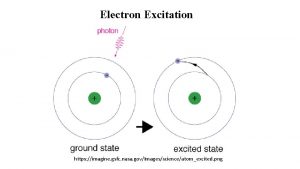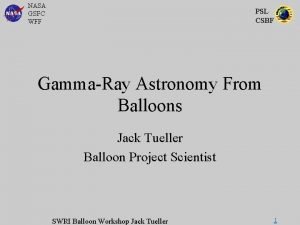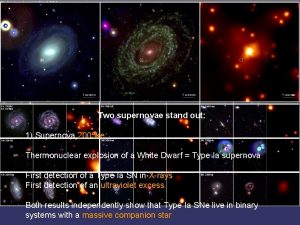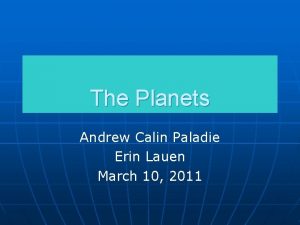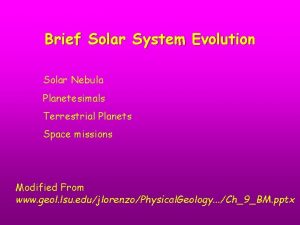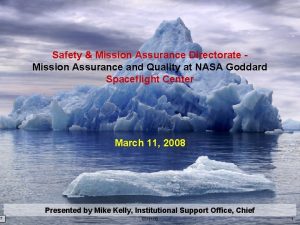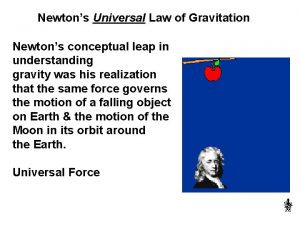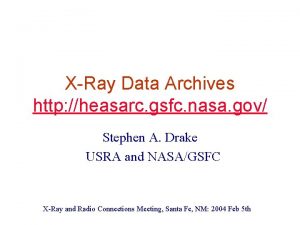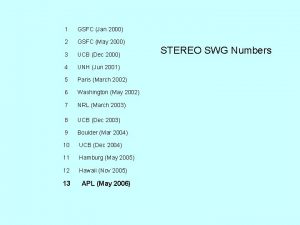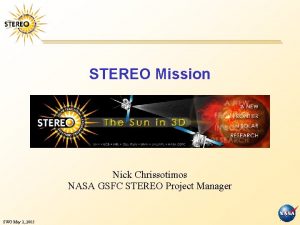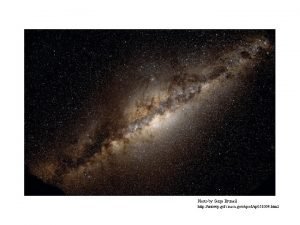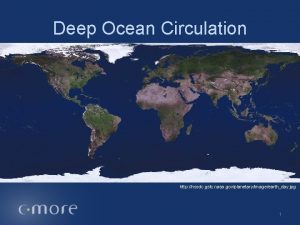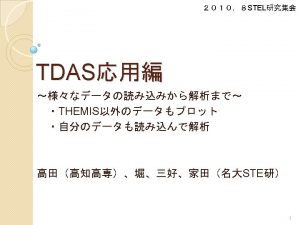Constellation Xray Mission http constellation gsfc nasa gov
























- Slides: 24

Constellation X-ray Mission http: //constellation. gsfc. nasa. gov Constellation-X

Constellation-X Mission Overview Constellation - X Use X-ray spectroscopy to observe – Black holes: strong gravity & evolution – Dark Matter throughout the Universe – Production and recycling of the elements Mission parameters – Telescope area: 3 m 2 at 1 ke. V An X-ray VLT 25 -100 times XMM/Chandra for high resolution spectroscopy – Spectral resolving power: 300 -3, 000 5 times better than Astro-E 2 at 6 ke. V – Band pass: 0. 25 to 40 ke. V 100 times RXTE sensitivity at 40 ke. V Enable high resolution spectroscopy of faint X-ray source populations Constellation-X

X-ray Spectroscopy Comes of Age The current threshold for finding X-ray selected AGN exceeds the spectroscopic capability of optical telescopes to identify the host galaxy (33% objects at I > 24) Chandra Log N - Log S High resolution (R>300) spectrometers on Chandra, XMM-Newton and Astro-E 2 typically reach fluxes where the sky density is 0. 1 to 1 sources per sq degree Constellation-X X-ray imaging has outstripped both optical and X-ray spectroscopy! Constellation-X will increase by a factor 1000 the number of sources available for high resolution spectroscopy Current capabilities Constellation-X will obtain high resolution spectra of the faint X-ray sources to determine redshift and source conditions Constellation-X

Constellation-X Mission Performance Two coaligned telescope systems cover the 0. 25 to 40 ke. V band SXT: Spectroscopy X-ray Telescope – 0. 25 to 10 ke. V – Effective area: è 15, 000 sq cm at 1 ke. V è 6, 000 sq cm at 6 ke. V – Resolution 300 -3000 with combination of è 2 e. V microcalorimeter array è reflection grating/CCD – 5 -15 arc sec HPD angular resolution è 5 arc sec pixels, 2. 5 arc min FOV HXT: Hard X-ray Telescope – 10 to 60 ke. V è 1, 500 sq cm at 40 ke. V – Energy resolution < 1 ke. V – 30 -60 arc sec HPD angular resolution Overall factor of 20 -100 increased sensitivity – gives ~ 1000 counts in 105 s for a flux of 2 x 10 -15 ergs cm-2 s-1 (0. 1 to 2. 0 ke. V) Constellation-X

Plasma Diagnostics with Constellation-X A Selection of He-like Transitions Observed by Constellation-X The Constellation-X energy band contains the K-line transitions of 25 elements allowing simultaneous direct abundance determinations using line-to-continuum ratios The spectral resolution of Constellation-X is tuned to study the He-like density sensitive transitions of Carbon through Zinc Constellation-X

Black Holes and Strong Gravity • Constellation-X will probe close to the event horizon with 100 times better sensitivity than before – Observe iron profile from close to the event horizon where strong gravity effects of General Relativity are seen – Investigate evolution of black hole properties by determining spin and mass over a wide range of luminosity and redshift Energy (ke. V) Simulated images of the region close to the event horizon illustrate the wavefront of a flare erupting above material spiralling into the black hole. The two spectra (1000 seconds apart) show substantial distortions due to GR effects. Constellation-X

Black Hole Evolution Chandra deep field has revealed what may be some of the most distant objects ever observed Chandra Sources making up the X-ray background QSO The earliest galaxies Galaxy ? The first black holes Empty Constellation-X will obtain high resolution spectra of these faintest X-ray sources to determine redshift and source conditions Constellation-X

Hidden Black Holes Many black holes may be hidden behind an inner torus or thick disk of material Photons/cm s 2 ke. V The Seyfert II Galaxy NGC 4945 Only visible above 10 ke. V where current missions have poor sensitivity AXAF/XMM Constellation-X Energy (ke. V) Constellation-X will use multi-layer coatings on focusing optics to increase sensitivity at 40 ke. V by >100 over Rossi XTE Constellation-X

Cosmology with Clusters of Galaxies seen in the optical image Hot gas dominates the X-ray image Planck Constellation-X z = 0. 8 cluster Microwave background and Xray surveys will find clusters at all redshifts Precision spectroscopy by Constellation-X of faintest, most distant clusters will determine redshift and cluster mass and the evolution of their parameters with redshift Constellation-X

The Missing Hydrogen Mystery An inventory of the visible matter in today’s Universe gives only 20% of the baryons (mostly Hydrogen) found at high redshift in the Lyman-alpha forest – Models for the formation of structure under the gravitational pull of dark matter predict the "unseen” baryons are in a 0. 1 to 1 million degree K intergalactic gas HST revealed ~15% of these predicted baryons using UV OVI absorption lines seen against bright background Quasars - most sensitive to 0. 1 million degree gas Constellation-X will search for the remainder and can detect up to ~70% using O VII and O VIII absorption lines - most sensitive to 1 million degree gas Together, UV and X-ray observations constrain the problem Constellation-X

Galactic Halos The composition and state of the tenuous hot halos of Galaxies can be accurately measured via K or L shell absorption of X-rays against background quasars NGC 1097 There are more than 300 bright X-ray galaxies for which such measurements can be made Grating NH = 5 x 1020 cm-2 Calorimeter NH = 5 x 1021 cm-2 Spectra of two typical quasars absorbed through two different hydrogen column densities in the ISM NGC 3067 Constellation-X

Constellation-X Mission Concept • A multiple satellite approach: – A constellation of multiple identical satellites – Each satellite carries a portion of the total effective area L 2 – Design reduces risk from any unexpected failure • Deep space (L 2) orbit allows: – High observing efficiency – Simultaneous viewing • Reference configuration: – Four satellites, launched two at a time on Atlas V class vehicle – Fixed optical bench provides a focal length of 10 m – Modular design allows: > Parallel development and integration of telescope module and spacecraft bus > Low cost standard bus architecture and components Constellation-X

Reference Design Spacecraft Bus Telescope Module High Gain Antenna 1. 6 m Diameter Spectroscopy X-ray Telescope Mirror and Gratings Solar Panel Sunshade Hard X-ray Telescope Mirrors (3) Optical Bench (enclosure removed for clarity) Hard X-ray Telescope Detectors (3) CCD Array Cooler with X-ray Calorimeter Launch Configuration Constellation-X

SXT Design Engineering Unit Prototype Unit Flight Unit Reflectors Outer Modules (2) Inner Module Housing Single inner module with Flight Scale Assembly of - 0. 5 m dia. reflector pair (replicated from Zeiss precision mandrel) - 3 modules (2 outer and 1 inner) - Parabolic (P) and Hyperbolic (H) submodules - First modules to be aligned using etched silicon microcombs - Largest diameter same as for flight 1. 6 m Full flight Assembly - 1. 6 m outer diameter - 18 Small Modules - 70 to 170 reflector diameters - Each module has 3 to 9 reflector pairs - Demonstrates module to module alignment Constellation-X

SXT Segmented X-ray Mirrors • Requirement: Highly nested reflectors with 1. 6 m outer diameter, low mass and overall angular resolution of 515 arc sec (HPD) – Segmented technology meets mass requirement – Requires 10 times improvement in resolution and 4 times increase in diameter compared to Astro-E 2 – Now the mission baseline - shell mandrels larger than 0. 7 m are not available, plus good progress made with demonstrating feasibility of segmented approach Small glass segment pair on alignment fixture • Recent Progress: – Demonstrated required performance at component level, necessary to begin system level testing – Successfully replicated glass segments from 0. 5 m precision Wolter Mandrel with performance limited by forming mandrel – Initiated Engineering Unit design – Initiated procurement for 1. 6 m diameter segment mandrel • Partners: GSFC, MIT, SAO, MSFC Etched Si alignment microcomb Constellation-X

SXT Engineering Unit • Goal is to approach Con-X resolution requirement in unit incorporating all aspects of SXT flight system - Precisely formed segments - Etched Si alignment bars - Flight assembly and metrology approach • EU is flight-like size (inner module) • Utilizes existing Zeiss metal mandrels (50 cm dia. ; 8. 4 m f. l. ; 5” surface) Reflectors Combs Strong-Backs Precision Actuators • Phased build up, with increasing complexity • Units will be tested in X-rays and subjected to environmental testing • Delivery mid-2003 Constellation-X

X-ray Calorimeters • Requirement: 2 e. V FWHM energy resolution from 1 to 6 ke. V at 1000 counts/s/pixel in 32 x 32 pixel array • Parallel Approach: Transition Edge Sensor (TES) and NTD/Ge Calorimeters • Progress: 3 mm – Demonstrated 2 e. V resolution at 1. 5 ke. V and 4 e. V at 6 2. 5 e. V (FWHM) ke. V using TES approach on demonstration devices @1. 5 ke. V – Achieved adequate thermal isolation and 2. 5 e. V resolution at 1. 5 ke. V using a flight sized TES device – Quantified TES detector noise to enable energy resolution budget – Fabricated 2 2 TES array for initial cross talk measurements – Demonstrated a new imaging TES approach that will potentially enable increase in field of view – Achieved 4. 8 e. V resolution over full range (1 -6 ke. V) with NTD/GE detector • Partners: GSFC, NIST, SAO, UW, LLNL, Stanford Constellation-X

Constellation-X Hard X-ray Telescope • Requirement: Maximum energy > 40 ke. V, effective area > 1500 cm 2, angular resolution < 1 arc min HPD, FOV 8 arc min, energy resolution < 10% • Approach: Depth-graded multilayer grazing incidence optics (shell or segmented) and Cd. Zn. Te pixel detectors • Progress: – Successful balloon flights (HERO and Infocus) in 2001 demonstrated first focused hard X-ray images – Improved Cd. Zn. Te detector performance > Energy resolution 390 e. V (at 18 ke. V) and 550 e. V (at 60 ke. V) > Threshold (theoretical) is 2 ke. V – 8 ke. V demonstrated – Demonstrated sputter coating on interior of cylindrical shells 68 ke. V image – Evaluated formed glass prototype optic with 5 coated surfaces glass prototype < 60 arc sec HPD and good reflectance at 60 ke. V (single bounce) – Partners: Caltech, GSFC, Columbia U. , MSFC, Harvard, SAO, NU, NRL Constellation-X

Reflection Grating Spectrometer In-plane Mount Constellation-X

Radial Groove Gratings Constellation-X

Primary Response <35% Response Extended CCD Potential for Greatly Improved Performance 10, 000 OP n= 3 O O -P -P 1 rim E/d. E – ter n= Mission Requirement n= 2 lo a C e 2 e. V ASSUMPTIONS: 5500 g/mm 15” SXT 2” gratings 2” alignment 1000 Mission Goal I-P n= 1 Mission Requirement I-P n= 2 100 0. 1 1. 0 Energy (ke. V) 10. 0 Constellation-X

Figure of Merit area x resolution ÷ 106 20 15 off-plane calorimeter 10 5 in-plane 0 0. 1 1. 0 Energy (ke. V) 10. 0 Constellation-X

Top Level Schedule (In-guide FY 07 New Start) 2001 2002 2003 2004 Pre-Formulation Pre-Phase A 2005 2006 2007 2008 2009 Formulation Phase A Instrument AO 2011 2012 2013 2014 2015 2016 Implementation Phase B SRR 2010 Phase C/D PDR/NAR CDR Phase E Launch Technology Development Optics Production Facilities and Mandrel Production Mission Concept Development Phase A Studies Award Prime/Preliminary Design and Build First Launch/Initial Operations Final Launch/Full Operations Constellation-X

Summary • Constellation-X emphasizes high throughput, high spectral resolution observations – the next major objective in X-ray astronomy – A High Priority Facility in the influential Mc. Kee-Taylor Decadal Survey • Mission design is robust and low risk – Assembly line production and multi-satellite concept reduces risk – First launch in 2010 timeframe – Facilitates ongoing science-driven, technology-enabled extensions • Substantial technical progress achieved – Replicated segmented reflector performance at component level – Calorimeter single pixel spectral resolution – Hard X-ray telescope optics and detector performance • Ramping up flight scale technology development program – On track to demonstrate critical milestones by FY 04 Constellation-X
 Imagine.gsfc.nasa/gov/docs/science/know_l1/emspectrum.html
Imagine.gsfc.nasa/gov/docs/science/know_l1/emspectrum.html Photojournal
Photojournal Http //nssdc.gsfc.nasa
Http //nssdc.gsfc.nasa Http //nssdc.gsfc.nasa
Http //nssdc.gsfc.nasa Nasa
Nasa Nasa gsfc
Nasa gsfc Psl mugshots
Psl mugshots Calipso data download
Calipso data download Http://solarsystem.nasa.gov/planets/
Http://solarsystem.nasa.gov/planets/ Http://solarsystem.nasa.gov/planets/
Http://solarsystem.nasa.gov/planets/ What are the benefits of space exploration
What are the benefits of space exploration Http://solarsystem.nasa.gov/planets
Http://solarsystem.nasa.gov/planets Http://pds.jpl.nasa.gov/planets/
Http://pds.jpl.nasa.gov/planets/ Wonder taste
Wonder taste Http://solarsystem.nasa.gov
Http://solarsystem.nasa.gov Http //mbs.meb.gov.tr/ http //www.alantercihleri.com
Http //mbs.meb.gov.tr/ http //www.alantercihleri.com Marshall space flight center map
Marshall space flight center map Gsfc
Gsfc Anong meron sa jeep tricycle at bus na wala sa eroplano
Anong meron sa jeep tricycle at bus na wala sa eroplano Nasa mission planner
Nasa mission planner Eol civil engineering
Eol civil engineering Earthobservatory.nasa.gov/features/world of change
Earthobservatory.nasa.gov/features/world of change @a..x.ze:it called:apod.nasa.gov
@a..x.ze:it called:apod.nasa.gov Nasa.gov
Nasa.gov Nasa.gov
Nasa.gov
